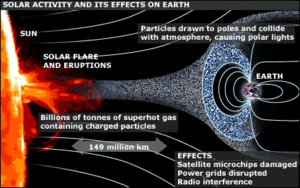DisastersNew method predicts communication-disrupting solar activity
Major solar eruptions (coronal mass ejections) normally take several days to reach the Earth, but the largest recorded in 1859 took just eighteen hours; solar flares — which can also cause significant disruption to communications systems — take just a few minutes; U.K. researchers develop a method of predicting solar storms that could help to avoid widespread power and communications blackouts

Cause of solar flare effects on earth // Source: bbc.co.uk
Researchers at Bradford University in Bradford, United Kingdom, have developed a new method of predicting solar storms that could help to avoid widespread power and communications blackouts.
>
Up to now, solar weather prediction has been done manually, with experts looking at 2D satellite images of the sun and assessing the likelihood of future activity. The team from Bradford University’s Center for Visual Computing, though, has created the first online automated prediction system, using 3D images generated from the joint NASA/ESA Solar and Heliospheric Observatory satellite (SOHO).
Already in use by both NASA and the European Space Agency (ESA), the Bradford Automated Solar Activity Prediction system (ASAP) identifies and classifies sun spots and then feeds this information through a model that can predict the likelihood of solar flares. The system is able accurately to predict a solar flare six hours in advance and the team is working to achieve a similar accuracy for the prediction of major solar eruptions in the near future.
Reader in visual computing, Dr. Rami Qahwaji, who led the EPSRC-funded research, said: “By creating an automated system that can work in real time, we open up the possibility for much faster prediction and — with sufficient data — prediction of a wider range of activity. With NASA’s new Solar Dynamic Observatory satellite, which came into operation in May, we have the chance to see the sun’s activity in much greater detail, which will further improve our prediction capabilities.”
The ASAP model is based on historical data, which was analyzed to identify patterns in the sun’s activity. Qahwaji is now applying for more funding to further improve the system and ensure it can be adapted to work with the latest sun-monitoring satellites.
